The Ultimate Guide to Omnichannel Strategy for 2025

Imagine a world where your customers move seamlessly between online and offline experiences without feeling a disconnect. Omnichannel strategies make this possible, transforming how businesses deliver value. Studies show that purchase and engagement rates in an omnichannel customer experience are 250% higher than single-channel campaigns. Retention rates soar by 90% for businesses embracing these approaches. With consumers using an average of six touchpoints during their purchase journey, the shift to omnichannel is no longer optional.
The 2025 Customer Marketing Tech Landscape Report emphasizes the need for businesses to stay ahead. Companies must rethink demand generation strategies, adapt to fragmented audiences, and personalize interactions. As 79% of executives plan to boost digital investments, tools like Sobot’s omnichannel service platform become indispensable for meeting these demands.
Understanding Omnichannel Strategy
What Is an Omnichannel Strategy
An omnichannel strategy focuses on creating a seamless and unified experience for your customers across all touchpoints. Whether they interact with your brand through a website, mobile app, social media, or physical store, the goal is to ensure consistency and continuity. This approach integrates all channels, allowing you to deliver personalized and efficient customer interactions.
Unlike traditional methods, an omnichannel strategy doesn't treat each channel as a separate entity. Instead, it connects them to provide a cohesive journey. For example, a customer might browse a product on your website, ask questions via live chat, and complete the purchase in-store—all without repeating their preferences or needs. This level of integration enhances the overall experience and builds trust.
The growth of omnichannel solutions highlights their importance.
The omni-channel retail solutions market was valued at USD 5.96 billion in 2021.
It is projected to grow at a compound annual growth rate (CAGR) of 13.6%, reaching USD 17.92 billion by 2030.
North America held a market share of 30.65% in 2021, showcasing significant adoption in the region.
Omnichannel vs. Multichannel vs. Cross-Channel
Understanding the differences between omnichannel, multichannel, and cross-channel approaches is crucial for selecting the right strategy for your business.
Approach | Description | Key Feature |
|---|---|---|
Multichannel | Engages customers through multiple channels, but each operates separately. | Channels work independently. |
Cross-Channel | Connects some channels for a smoother experience, but not all are linked. | Partial integration between channels. |
Omnichannel | Fully integrates all channels to create a unified customer experience. | Seamless and consistent across channels. |
A multichannel approach might involve offering support through email and phone, but these channels don't share data. Cross-channel strategies take it a step further by linking some channels, such as allowing customers to order online and pick up in-store. However, only an omnichannel approach ensures that every interaction feels connected, regardless of the platform.
Why Omnichannel Is the Future of Customer Experience
The future of customer experience lies in omnichannel strategies. Customers now expect consistent and personalized interactions across all platforms. Meeting these expectations requires a unified approach that integrates technology, data, and communication channels.
Statistic | Value | Source |
|---|---|---|
Customer retention with omnichannel strategies | Aberdeen Group | |
Consumers who say AI enhances CX | 73% | Capgemini |
Customers expecting consistent interactions | 90% | SDL |
Customers desiring omnichannel experience | 90% | Fluent Support |
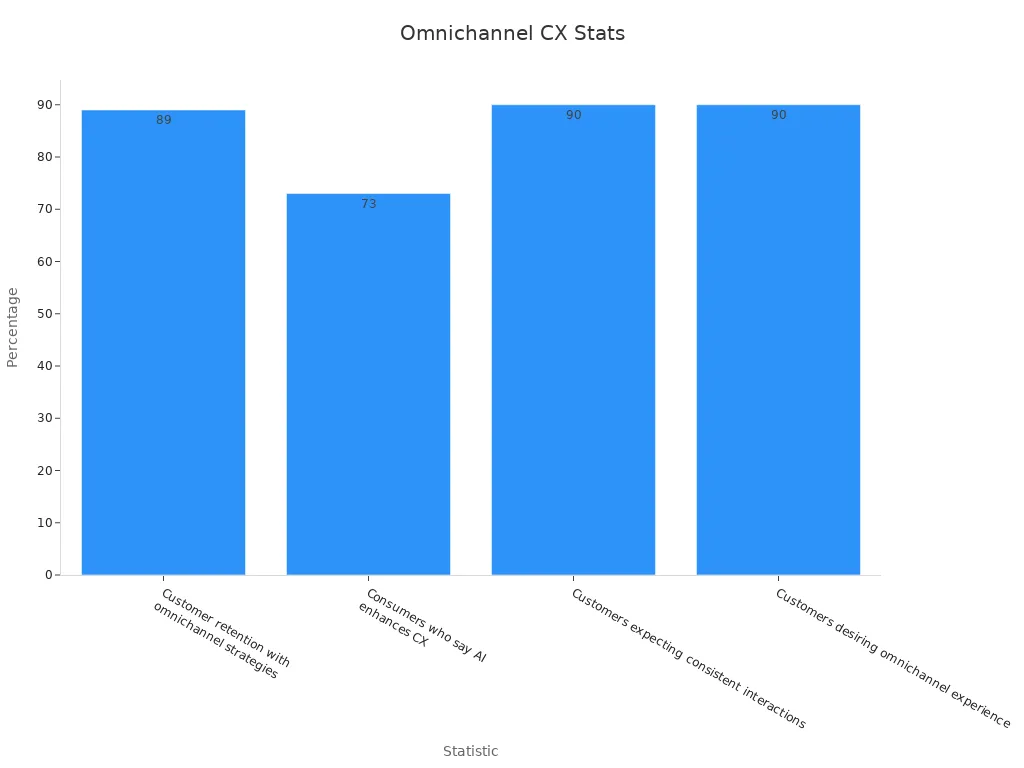

Omnichannel strategies enhance customer satisfaction by integrating interactions across multiple channels. Key factors for success include personalization, channel integration, and consistency. For example, tools like Sobot's omnichannel service platform unify customer interactions, enabling you to deliver a seamless experience. This effective omnichannel approach not only improves customer loyalty but also gives you a competitive edge in the market.
Benefits of an Omnichannel Strategy for Businesses
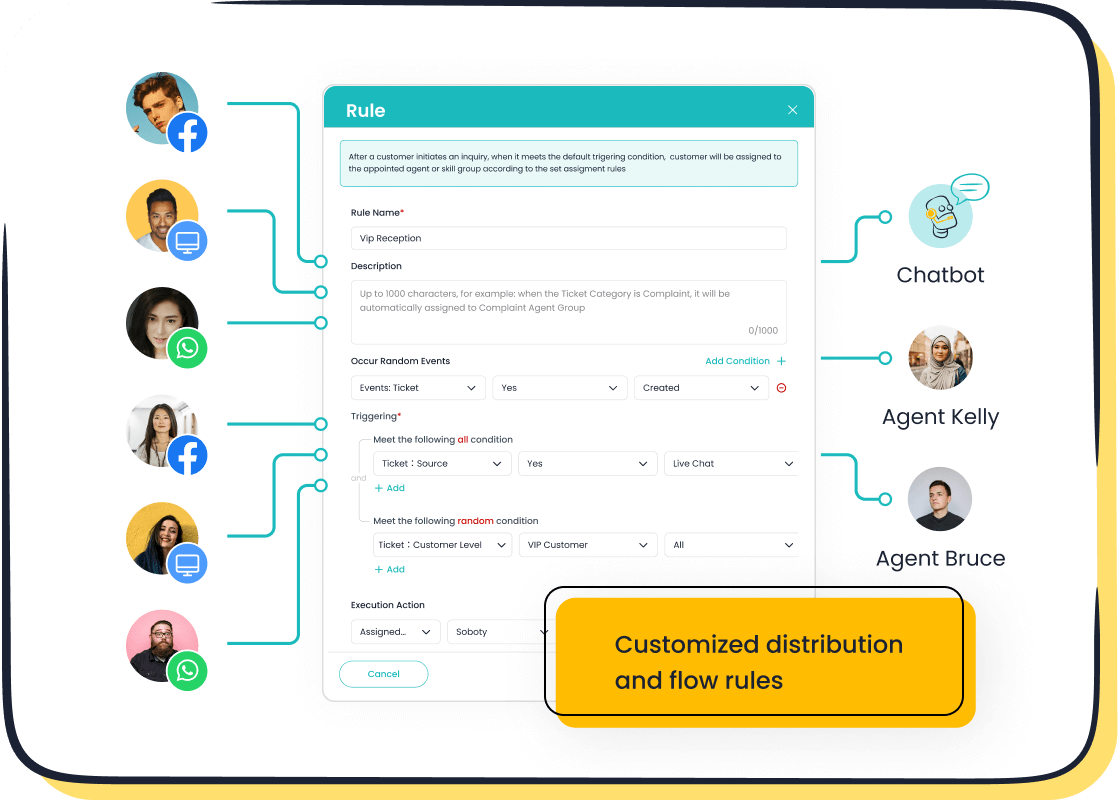
Delivering Improved Customer Experience
An omnichannel strategy ensures a unified customer experience by connecting all touchpoints seamlessly. This approach eliminates customer pain points and enhances satisfaction. Brands adopting omnichannel marketing often see significant benefits:
A 7.5% annual decrease in cost per contact.
Real-time data insights that continuously improve customer engagement.
By understanding customer segments, you can tailor interactions to meet their preferences. For instance, promoting eco-friendly products to environmentally conscious customers creates a more personalized marketing experience. In today’s economy, customers prioritize enhanced experiences over price, making omnichannel marketing essential for success.
Boosting Customer Loyalty and Retention
Omnichannel strategies foster increased customer loyalty by delivering consistent and personalized interactions. Customers value brands that understand their needs and provide seamless experiences across channels. Statistics show that 54% of companies focusing on loyalty achieve better retention rates through omnichannel marketing.
When you integrate cross-channel marketing, customers feel valued and understood. This connection strengthens their trust in your brand, encouraging repeat purchases and long-term engagement. A unified customer experience not only retains customers but also turns them into advocates for your business.
Enhancing Operational Efficiency
Implementing an omnichannel strategy streamlines operations and reduces costs. Retailers using unified commerce platforms report a 22% reduction in operating costs compared to disconnected systems. Improved targeting lowers customer acquisition costs by up to 50%, while unified checkout solutions increase the likelihood of repeat purchases by 77%.
Businesses like Pepper Palace and Oak + Fort have demonstrated the efficiency of omnichannel marketing. Pepper Palace saved $20,000 annually by cutting middleware costs and expanded to 60 new locations in one year. Oak + Fort reduced staff time by 50 hours weekly at headquarters and saved 80 hours weekly across retail locations. These examples highlight how omnichannel strategies optimize resources and drive growth.
Leveraging Data Insights for Better Decision-Making
Data insights play a crucial role in shaping effective omnichannel strategies. By analyzing customer behavior and preferences, you can make informed decisions that enhance customer experiences and drive business growth. Leveraging data allows you to identify trends, optimize campaigns, and deliver personalized interactions across all channels.
One example of effective data integration comes from omnichannel analytics platforms. These platforms merge data from sources like Treez and Google Analytics, handling over 1.5 million entries. Advanced tools such as Python, SQL, and AWS Lambda streamline this process. The result is a unified system that transforms scattered data into actionable insights. Here's a closer look:
Aspect | Details |
|---|---|
Data Integration Mastery | Merged data from platforms like Treez and Google Analytics, handling over 1.5 million entries. |
Technology Leveraged | Utilized tools such as Python, SQL, and AWS Lambda to streamline data integration. |
Client's Needs Met | Enhanced messaging and market entry campaigns through coherent data formats. |
Challenges Overcome | Addressed issues like scattered data and duplicate IDs in the Redshift database. |
Solutions Powered by Analytics | Integrated ETL tools and APIs to transform collected data into actionable insights. |
Continued Success | Established a system that continuously provides updated insights, driving informed decisions. |
Another success story involves LiveVox, which partnered with GoodData to enhance reporting capabilities. This collaboration integrated diverse datasets, including emails, texts, chats, and CRM systems. The result? A comprehensive customer view that enabled detailed dashboards. These dashboards improved customer experiences and optimized decision-making.
Tip: Use tools like Sobot's omnichannel service platform to unify customer data and gain actionable insights. This approach helps you understand customer journeys and refine your strategies effectively.
By leveraging data insights, you can stay ahead of customer expectations and make smarter business decisions. Data-driven strategies not only improve operational efficiency but also foster stronger customer relationships.
Steps to Implement an Omnichannel Strategy
Mapping the Customer Journey
Mapping the customer journey is the foundation of implementing an omnichannel strategy. It involves understanding how your customers interact with your brand across various touchpoints. By identifying these interactions, you can create a seamless experience that meets their expectations.
Start by visualizing the entire journey, from the moment a customer discovers your brand to post-purchase engagement. Break this journey into stages such as awareness, consideration, purchase, and loyalty. For each stage, identify the channels your customers use and the challenges they face. For example, a customer might research products on your website, seek support via live chat, and complete their purchase in-store. Understanding these behaviors helps you address pain points and optimize the experience.
Use tools like customer surveys, analytics platforms, and heatmaps to gather insights. These tools reveal patterns in customer behavior, enabling you to refine your approach. For instance, if customers abandon their carts during checkout, you can implement features like saved carts or personalized reminders to re-engage them. Mapping the customer journey ensures that every interaction feels connected, paving the way for a successful omnichannel strategy.
Tip: Regularly update your customer journey map to reflect changing behaviors and preferences. This keeps your strategy relevant and effective.
Unifying Data Across Channels with Sobot's Omnichannel Service Platform
Unifying data across channels is critical for delivering a consistent and personalized experience. Sobot's omnichannel service platform excels in this area by consolidating customer data into a single, unified workspace. This integration eliminates data silos, allowing you to access real-time insights and provide tailored interactions.
With Sobot's platform, you can integrate communication channels like email, social media, live chat, and voice calls. This ensures that your agents have a 360-degree view of the customer, enabling them to resolve issues efficiently. For example, if a customer contacts you via WhatsApp and later follows up through email, the platform connects these interactions, ensuring continuity.
The benefits of unifying data are clear:
Metric | Value |
|---|---|
Increase in agent efficiency | |
Customer satisfaction score | 97% |
These metrics highlight how Sobot's omnichannel service platform enhances both operational efficiency and customer satisfaction. By leveraging this platform, you can streamline workflows, reduce response times, and build stronger relationships with your customers.
Note: A unified data system not only improves efficiency but also empowers your team to make data-driven decisions, driving long-term success.
Integrating Online and Offline Channels
Integrating online and offline channels is essential for creating a cohesive omnichannel customer journey. Customers expect a seamless transition between digital and physical experiences, and businesses that meet this expectation gain a competitive edge.
Successful examples of integration include:
Starbucks integrates its mobile app with in-store experiences, allowing customers to order and pay ahead, enhancing convenience and personalization.
Nike transforms retail spaces into interactive experiences, utilizing digital technology for product browsing and in-store pickups, effectively merging online and offline shopping.
A survey indicates that companies with robust omnichannel strategies retain 89% of customers, showcasing the effectiveness of such approaches.
A study reveals that 73% of consumers engage with multiple channels during their shopping journey, emphasizing the need for a cohesive omnichannel experience.
To achieve this integration, focus on connecting your digital platforms with physical locations. For instance, enable features like 'buy online, pick up in-store' (BOPIS) or use QR codes created with The QR Code Generator (TQRCG) in-store to provide additional product information. Sobot's omnichannel service platform supports this by unifying customer interactions, ensuring that online and offline touchpoints work together seamlessly.
Tip: Use analytics to track customer behavior across channels. This helps you identify gaps and refine your integration strategy for a more unified experience.
Personalizing Interactions with AI and Automation
AI and automation have revolutionized how businesses deliver personalized experiences. These technologies analyze customer data to tailor interactions, ensuring every touchpoint feels relevant and engaging. For example, AI can aggregate data from multiple channels into a single profile, giving you a comprehensive view of customer preferences. This allows you to offer consistent messaging and tailored recommendations that resonate with individual needs.
Benefit/Impact | Description |
|---|---|
Comprehensive view of customer profiles | AI aggregates data from various channels into a single customer profile, enhancing personalization. |
Real-time personalization | AI analyzes data in real time to deliver tailored content and recommendations. |
Higher engagement rates | Personalized interactions lead to increased customer engagement and loyalty. |
Improved conversion rates | Relevant interactions through AI result in better conversion rates. |
AI-powered tools like Sobot’s Live Chat platform take personalization to the next level. By leveraging AI, you can deliver real-time responses that align with customer preferences. For instance, Sobot’s platform uses intelligent assignment to route inquiries to the right agent, ensuring faster resolutions. It also employs auto-translation to communicate seamlessly with customers in their preferred language, fostering stronger connections.
Automation complements AI by streamlining repetitive tasks. Chatbots powered by natural language processing can handle common queries, freeing up your team to focus on complex issues. These bots engage in contextual conversations, making interactions feel more human. This combination of AI and automation not only enhances customer engagement but also boosts operational efficiency.
Tip: Use tools like Sobot’s omnichannel service platform to unify customer data and automate workflows. This ensures every interaction feels personalized and consistent across channels.
Training Teams for Consistency Across Touchpoints
Your team plays a crucial role in delivering a seamless omnichannel experience. Consistent service across all touchpoints builds trust and strengthens customer loyalty. Training programs that align your team’s goals and protocols are essential for achieving this consistency.
Standardized training ensures every team member understands your brand’s values and messaging. This reduces misrepresentation and confusion, creating a unified customer experience. Techniques like mystery shopping and performance audits help identify service quality gaps, allowing you to address inconsistencies proactively. For example, empowering employees to resolve issues on the spot enhances service reliability.
Key Training Outcomes:
Creates company-wide understanding and elevates brand awareness.
Reduces brand misrepresentation, minimizing inconsistencies that confuse customers.
Empowers employees to become effective brand advocates.
Customer feedback is another valuable tool for refining your training approach. Actively seeking input helps you identify areas for improvement and adapt your strategies. Platforms like Sobot’s Live Chat provide built-in analytics that measure service quality, enabling you to track progress and optimize team performance.
Note: Regular communication within your team ensures alignment and fosters collaboration. Use dashboards to monitor metrics like response times and customer satisfaction scores, keeping your team focused on delivering consistent service.
Overcoming Challenges in Omnichannel Strategy Implementation
Ensuring Consistency Across Channels
Consistency across channels is vital for delivering a seamless customer experience. Customers expect uniform messaging, tone, and service quality, whether they interact with your brand online or offline. However, maintaining this consistency presents several challenges:
Data integration often becomes complex due to mismatched formats and disparate sources. These issues make it difficult to create unified customer profiles.
Synchronizing communication across multiple touchpoints can lead to inconsistencies, frustrating customers and reducing trust.
Automation tools, while helpful, must be carefully managed to retain a human touch in interactions.
To overcome these obstacles, you need a well-defined communication strategy. Focus on aligning content, timing, and context across all channels. Tools like Sobot’s omnichannel service platform simplify data consolidation, ensuring your team has access to accurate customer insights. By leveraging automation thoughtfully, you can enhance efficiency without sacrificing personalization.
Tip: Regularly audit your messaging across channels to identify inconsistencies and refine your approach.
Achieving Organizational Alignment
Organizational alignment is crucial for executing a successful omnichannel strategy. Resistance to change, lack of leadership support, and siloed departments often hinder collaboration. These barriers prevent teams from working together effectively, making it difficult to integrate channels seamlessly.
To address these challenges, consider the following steps:
Conduct an organizational structure review to identify gaps in alignment.
Assess leadership capacity to ensure executives actively support the strategy.
Clarify roles and responsibilities to eliminate confusion and foster collaboration.
Breaking down silos is essential for cross-functional teamwork. Encourage open communication and shared goals among departments. For example, marketing and customer service teams should collaborate to ensure consistent messaging and service delivery. Unified efforts lead to smoother implementation and better results.
Note: Leadership plays a pivotal role in driving alignment. Ensure executives champion the strategy and inspire teams to embrace change.
Managing Technology and Data Integration
Technology and data integration form the backbone of an omnichannel strategy. Businesses with strong integration retain 89% of their customers annually, while those with poor implementation achieve only 33%. Unified engagement strategies also boost customer lifetime value by 30% and increase per-purchase spending by 10-15%.
To manage technology effectively, prioritize platforms that unify data from multiple channels. Sobot’s omnichannel service platform consolidates customer interactions, providing a 360-degree view that enhances decision-making. Use analytics to identify trends and optimize campaigns.
Data integration challenges often stem from scattered sources and duplicate entries. Address these issues by implementing robust ETL (Extract, Transform, Load) tools and APIs. These technologies streamline data processing, ensuring accuracy and consistency.
Tip: Invest in scalable solutions that grow with your business needs. This ensures long-term success and adaptability in a dynamic market.
Measuring ROI and Success Metrics
Measuring the ROI of your omnichannel strategy helps you understand its financial impact and overall effectiveness. ROI goes beyond profits. It includes increased sales, customer loyalty, and reduced operating costs. By tracking specific metrics, you can maximize the value of each customer interaction.
Key Metrics to Track
To evaluate the success of your strategy, focus on metrics that reflect customer satisfaction, channel utilization, and financial returns. Here are four essential metrics:
Customer retention rates: Higher retention indicates satisfaction and loyalty.
Channel utilization metrics: These track how customers use each channel.
Cost per customer served: Lower costs show improved efficiency.
Revenue per customer visit: This measures the financial returns of your strategy.
Financial Benefits of Omnichannel Strategies
Omnichannel strategies deliver measurable financial benefits. Businesses using three or more channels see a 287% higher purchase rate compared to single-channel approaches. Customer retention rates also increase by 90%, demonstrating the long-term value of a unified experience.
Metric | Value |
|---|---|
Purchase rate increase | 287% higher with 3+ channels |
Customer retention increase | 90% higher with omnichannel |
Tips for Maximizing ROI
Analyze customer behavior: Use tools like Sobot’s omnichannel service platform to track interactions and identify trends.
Optimize channel performance: Focus on the channels that drive the most engagement and revenue.
Reduce operating costs: Automate repetitive tasks with AI-powered tools to improve efficiency.
Note: Regularly review your metrics to ensure your strategy aligns with customer needs and business goals. Continuous improvement leads to sustained success.
Future Trends in Omnichannel Strategies for 2025
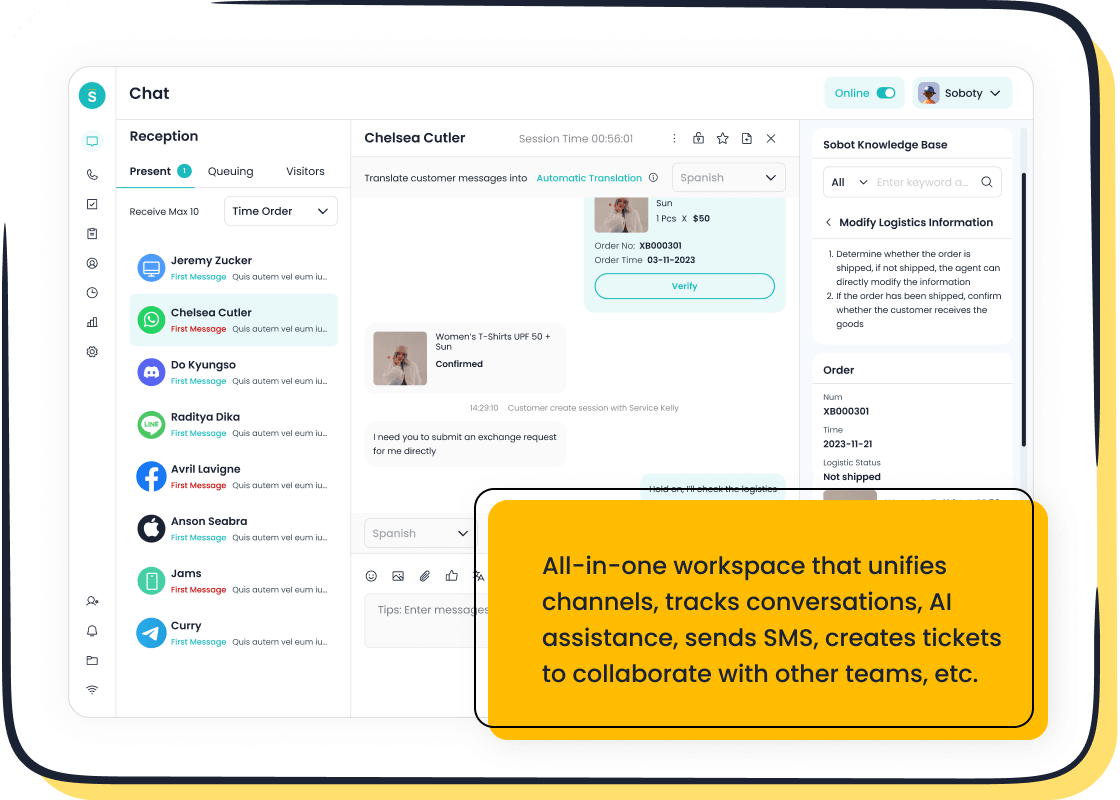
AI-Driven Personalization and Predictive Analytics
AI-driven personalization is transforming how you connect with customers. By analyzing data in real time, AI tailors interactions to meet individual preferences, creating a seamless experience. Predictive analytics takes this further by forecasting customer behavior, enabling you to anticipate needs and deliver proactive solutions.
A survey by Deloitte reveals that 44% of retail executives plan to enhance omnichannel experiences by 2025.
The e-commerce market's use of AI is projected to grow from $7.25 billion in 2024 to $9.01 billion in 2025, with a CAGR of 24.34% through 2034.
Sobot’s Live Chat platform exemplifies this trend. It uses AI to segment customers, provide real-time responses, and offer personalized recommendations. These features not only improve customer satisfaction but also boost conversion rates. As AI adoption accelerates, businesses like yours can leverage these tools to stay ahead in delivering exceptional customer experiences.
Seamless Online-Offline Integration with Tools Like Sobot Live Chat
Customers expect a seamless experience when transitioning between online and offline channels. Integrating these touchpoints ensures consistency and convenience. For example, BOPIS (Buy Online, Pick Up In Store) has become a significant trend, merging the speed of e-commerce with the immediacy of in-store shopping.
Sobot’s omnichannel service platform supports this integration by unifying customer interactions across digital and physical spaces. Whether a customer browses online or visits your store, Sobot ensures their journey feels connected. Features like unified messaging and real-time updates help you deliver a cohesive experience.
Brands that embrace this integration see tangible benefits. Companies with robust omnichannel strategies retain 89% of their customers, while omnichannel shoppers spend 1.7x more than single-channel shoppers. By adopting tools like Sobot, you can bridge the gap between online and offline, enhancing both loyalty and revenue.
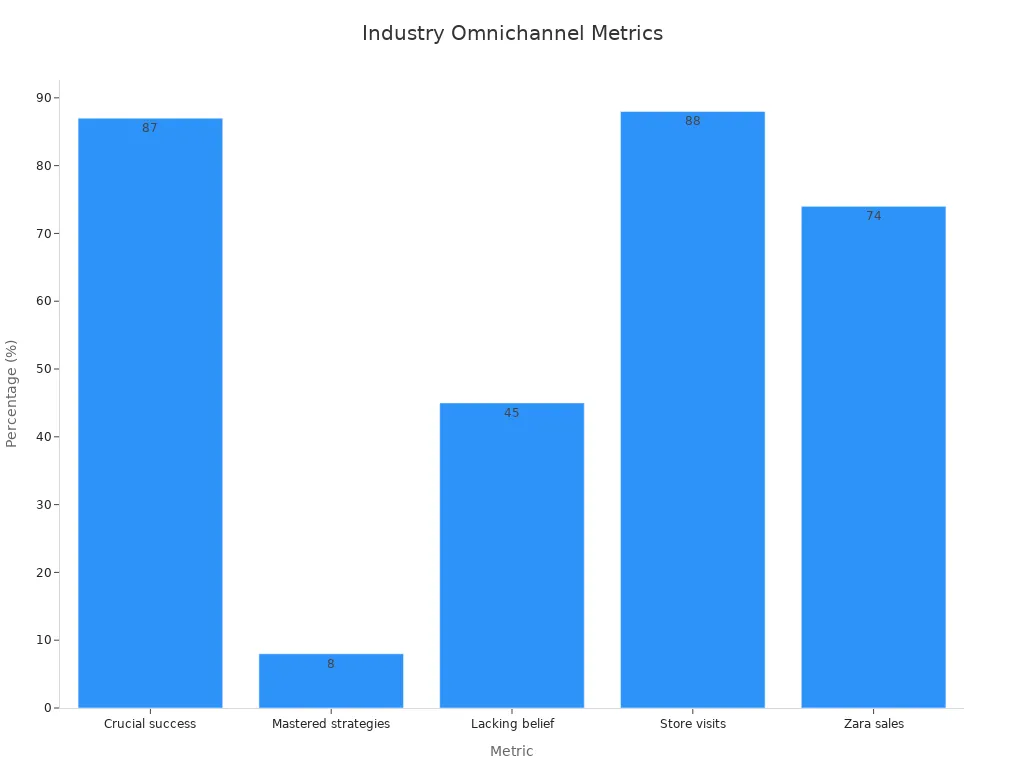
Voice and Conversational Commerce
Voice and conversational commerce are reshaping how customers interact with brands. Voice assistants like Alexa and Google Assistant enable hands-free shopping, while chatbots provide instant support. These technologies enhance convenience and foster deeper engagement.
Metric | Value |
|---|---|
Increase in average order value | +23% |
Higher customer lifetime value | +31% |
Improved repeat purchase rates | 2.4x higher |
Increased customer satisfaction scores | NPS improvements of 15-20 points |
Additional spending by multi-channel customers | 4% more in-store, 10% more online |
Annual spending increase with voice usage | 18% more annually |
Sobot’s Live Chat platform integrates conversational AI to handle inquiries efficiently. Its multilingual chatbot ensures accessibility, while features like auto-translation and intelligent routing enhance the customer experience. By adopting voice and conversational commerce, you can meet evolving expectations and drive growth in 2025.
Sustainability and Ethical Consumerism in Omnichannel
Sustainability has become a priority for modern consumers. Millennials and Gen Z, in particular, actively seek eco-friendly products and ethical business practices. This shift stems from growing awareness of climate change and the importance of fair labor. As a result, brands that embrace transparency and social responsibility gain a competitive edge. For example, companies that disclose their supply chain practices and commit to reducing their carbon footprint attract more loyal customers.
Modern shoppers also consider the environmental impact of their purchases. Many prefer brands that use sustainable packaging or offer recycling programs. Approximately 65% of consumers in emerging markets like India are even willing to pay more for sustainable products. Globally, sustainable brands have grown three times faster than their non-sustainable counterparts over the past two years. These trends highlight the importance of integrating sustainability into your omnichannel strategy.
You can align your business with these values by adopting green practices across all channels. For instance, digital receipts and paperless communication reduce waste while enhancing convenience. Tools like Sobot’s omnichannel service platform can help you track customer preferences for eco-friendly options, ensuring personalized and ethical interactions. By prioritizing sustainability, you not only meet customer expectations but also contribute to a better future.
Emerging Technologies Shaping Omnichannel (e.g., AR/VR)
Emerging technologies like augmented reality (AR) and virtual reality (VR) are revolutionizing omnichannel strategies. These tools create immersive experiences that bridge the gap between online and offline shopping. For example, AR allows customers to visualize products in their homes before purchasing. IKEA’s AR app lets users see how furniture fits into their space, enhancing confidence in their buying decisions.
VR takes customer engagement to the next level by offering virtual store tours or product demonstrations. Retailers like Sephora use VR to let customers try on makeup virtually, providing a personalized and interactive experience. These technologies not only improve customer satisfaction but also increase conversion rates.
Sobot’s omnichannel solutions can integrate AR/VR capabilities into your customer journey. For instance, you can use Sobot’s Live Chat to guide customers through AR-powered product previews or VR consultations. By adopting these innovations, you stay ahead of trends and deliver cutting-edge experiences that resonate with tech-savvy audiences.
Tip: Start small by incorporating AR features into your mobile app or website. Gradually expand to VR experiences as customer demand grows.
Adopting an omnichannel strategy is no longer optional—it’s essential for staying competitive in 2025. Businesses that embrace this approach see measurable improvements in customer engagement, loyalty, and satisfaction. For example, key performance indicators like engagement scores and cross-channel conversion rates highlight the effectiveness of omnichannel strategies:
KPI | Description |
|---|---|
Engagement score | Measures the level of customer engagement with omnichannel marketing strategies. |
Loyalty score | Indicates the number of customers who remain loyal to the brand, reflecting the effectiveness of the strategy. |
Net Promoter Score (NPS) | Evaluates customer satisfaction and loyalty, helping identify areas for improvement in marketing strategies. |
Customer Satisfaction Score | Assesses customer feedback and satisfaction with the overall customer journey. |
Cross-channel conversion rate | Tracks the percentage of customers making purchases after engaging with omnichannel marketing. |
Customer Lifetime Value | Measures the total value a customer brings over their entire journey, indicating the long-term success of the strategy. |
Sobot’s omnichannel solutions empower businesses to unify customer interactions, reduce operational inefficiencies, and enhance service quality. Metrics like a 97% customer satisfaction score and an 85% problem resolution rate demonstrate the platform’s impact.
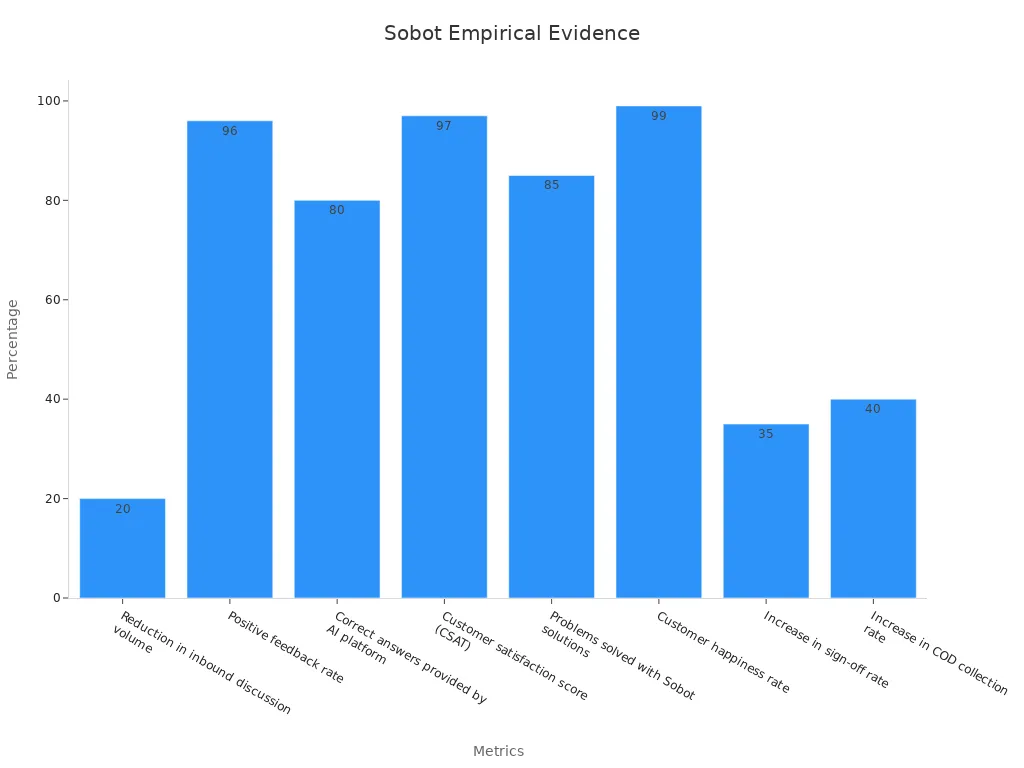
Now is the time to act. Start refining your omnichannel strategy today to deliver seamless experiences, build stronger customer relationships, and secure your competitive edge.
FAQ
What is the difference between omnichannel and multichannel strategies?
Omnichannel strategies integrate all channels to create a seamless customer experience. Multichannel strategies, on the other hand, use multiple channels that operate independently. Omnichannel ensures consistency across touchpoints, while multichannel lacks this integration.
Tip: Use omnichannel strategies to deliver a unified experience and build stronger customer relationships.
How can Sobot's omnichannel platform improve my business?
Sobot's platform unifies customer interactions across channels like email, social media, and live chat. It boosts efficiency by 30% and enhances customer satisfaction with real-time insights. You can streamline workflows, reduce response times, and deliver personalized experiences.
Note: Sobot's tools also help you make data-driven decisions for long-term success.
Why is mapping the customer journey important?
Mapping the customer journey helps you understand how customers interact with your brand. It identifies pain points and optimizes experiences at every stage. This ensures a seamless and personalized journey, improving satisfaction and loyalty.
Tip: Regularly update your journey map to reflect changing customer behaviors.
Can AI and automation enhance omnichannel strategies?
Yes, AI and automation personalize interactions and streamline repetitive tasks. AI analyzes customer data for tailored recommendations, while automation handles common queries. Together, they improve engagement, efficiency, and satisfaction.
Example: Sobot’s Live Chat uses AI for intelligent routing and auto-translation, ensuring faster and more relevant responses.
How do I measure the success of my omnichannel strategy?
Track metrics like customer retention, satisfaction scores, and cross-channel conversion rates. These indicators show how well your strategy meets customer needs and drives business growth.
Metric | Purpose |
|---|---|
Customer retention rate | Measures loyalty and satisfaction |
Cross-channel conversion | Tracks purchases across platforms |
Customer lifetime value | Evaluates long-term profitability |
Note: Use tools like Sobot’s analytics to monitor and refine your strategy.
See Also
Essential Guide for Choosing Omnichannel Call Center Tools
Ten Key Steps for Successful Omnichannel Contact Center Setup
Discovering Leading Cloud Contact Centers for 2025
